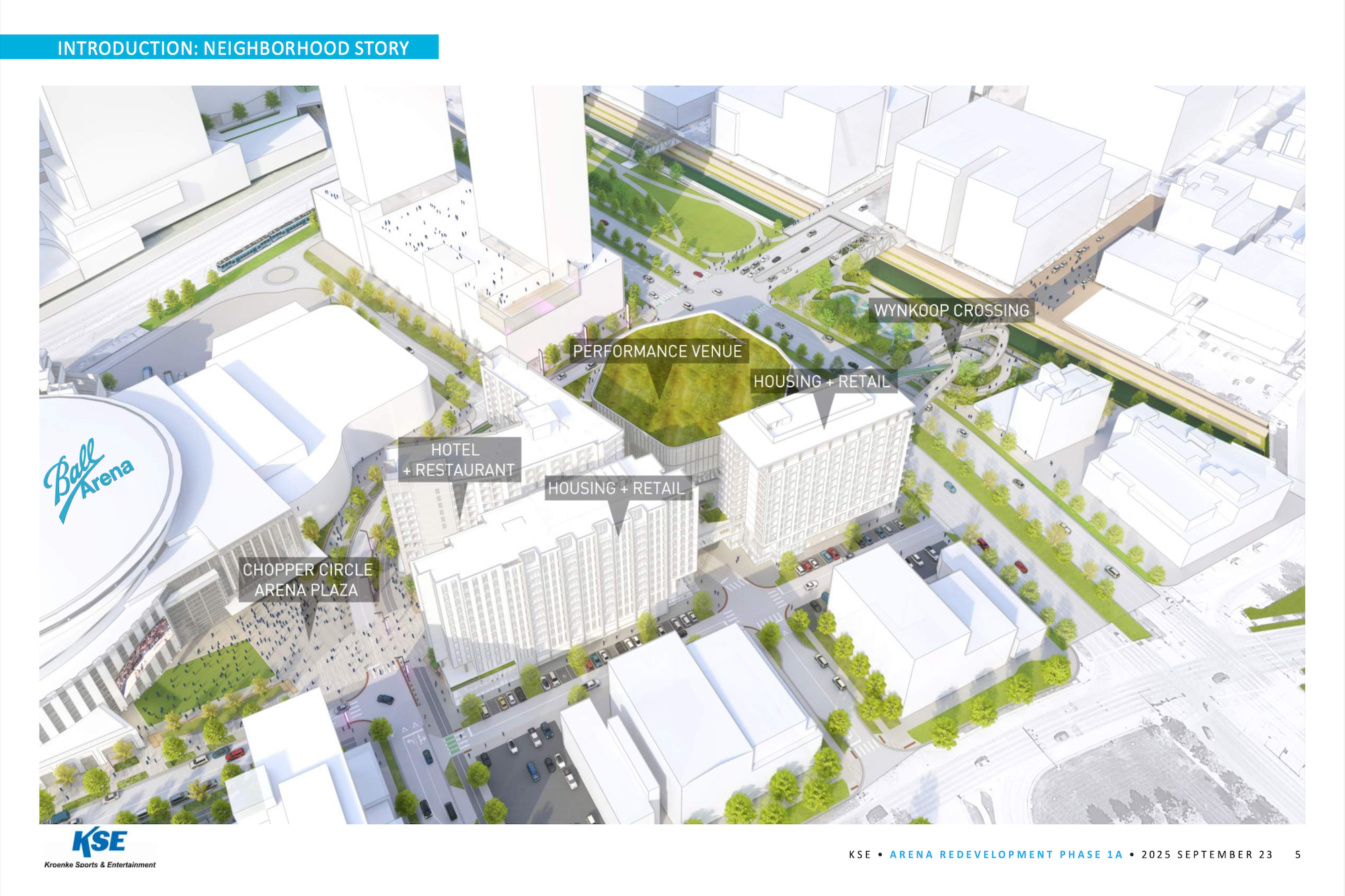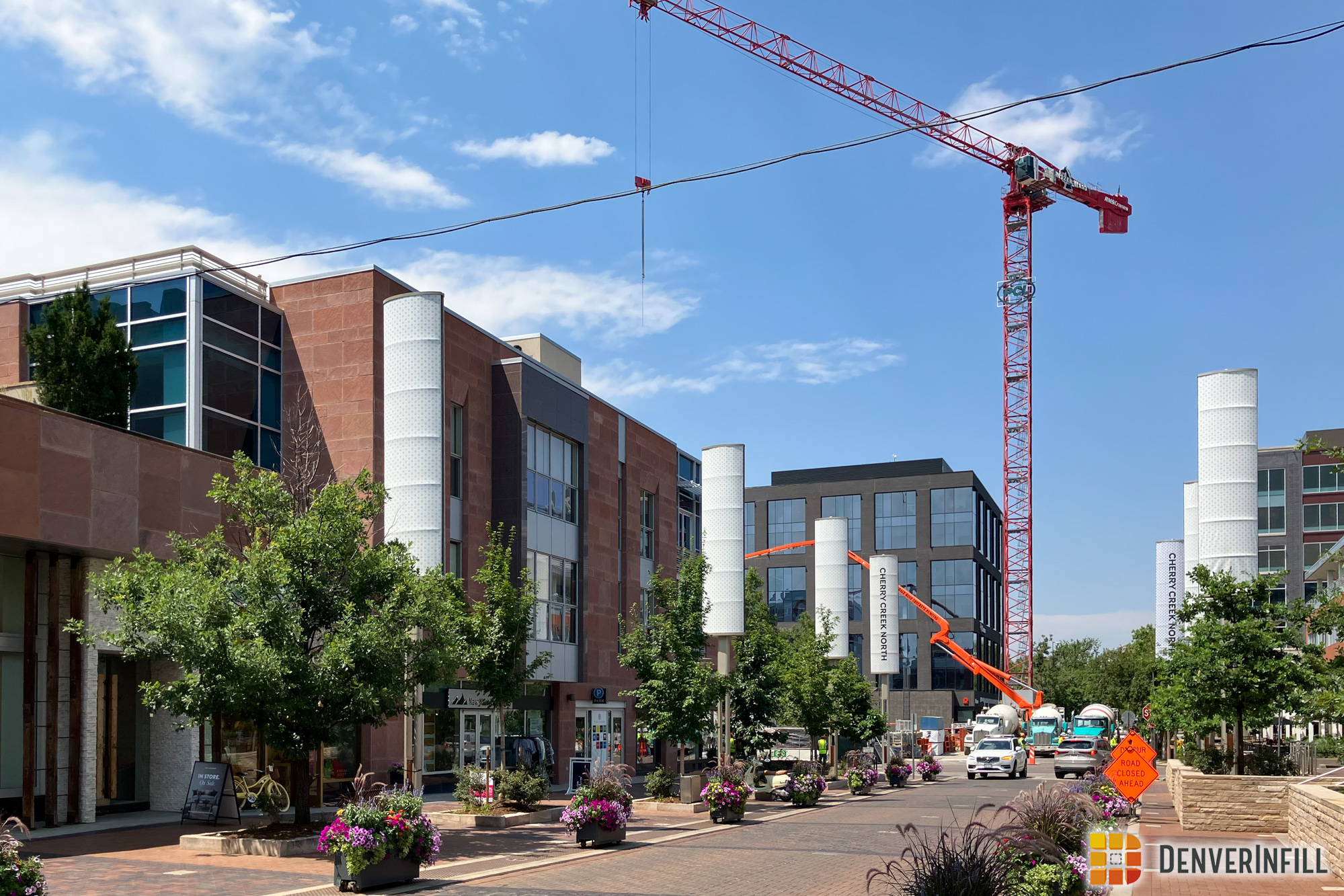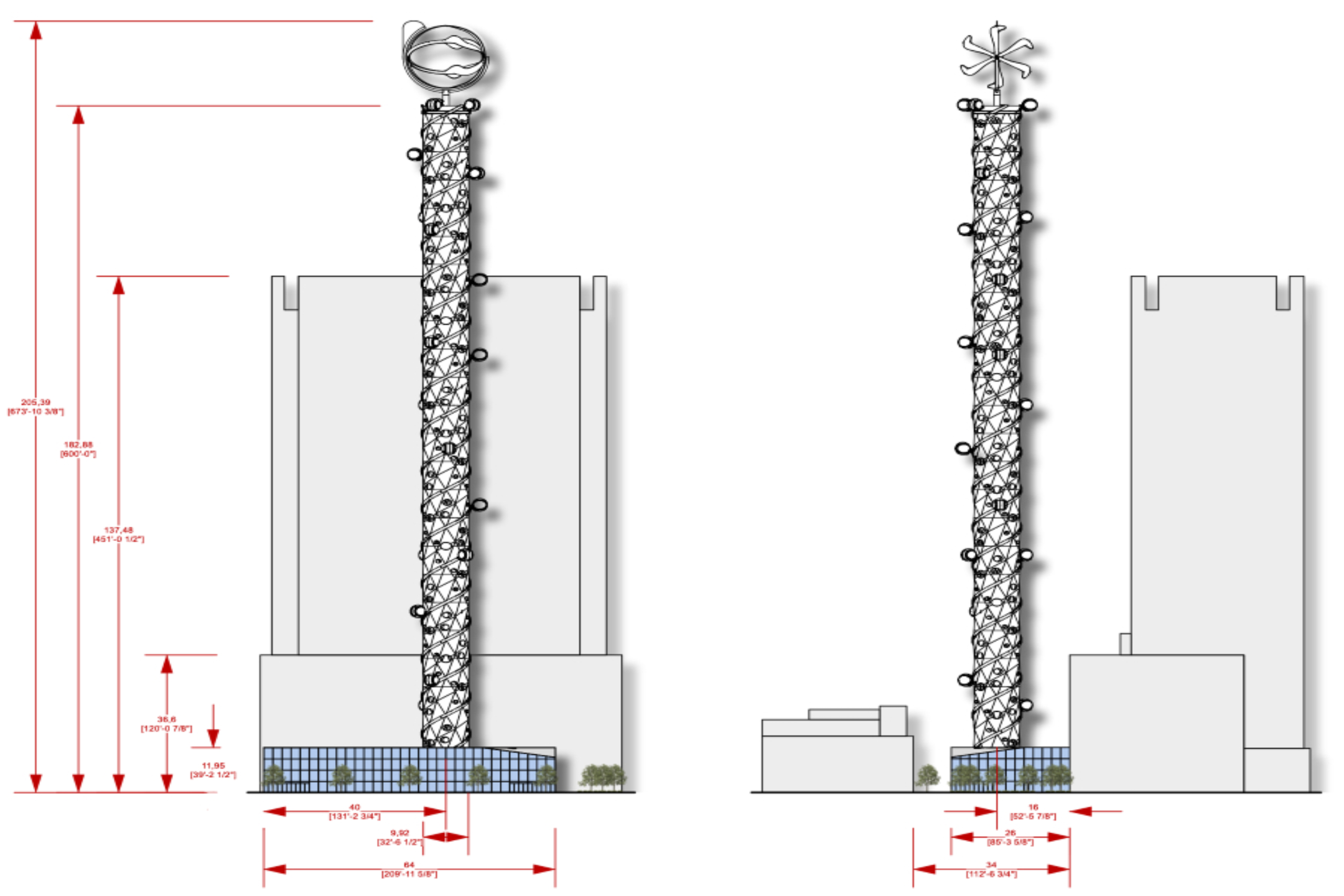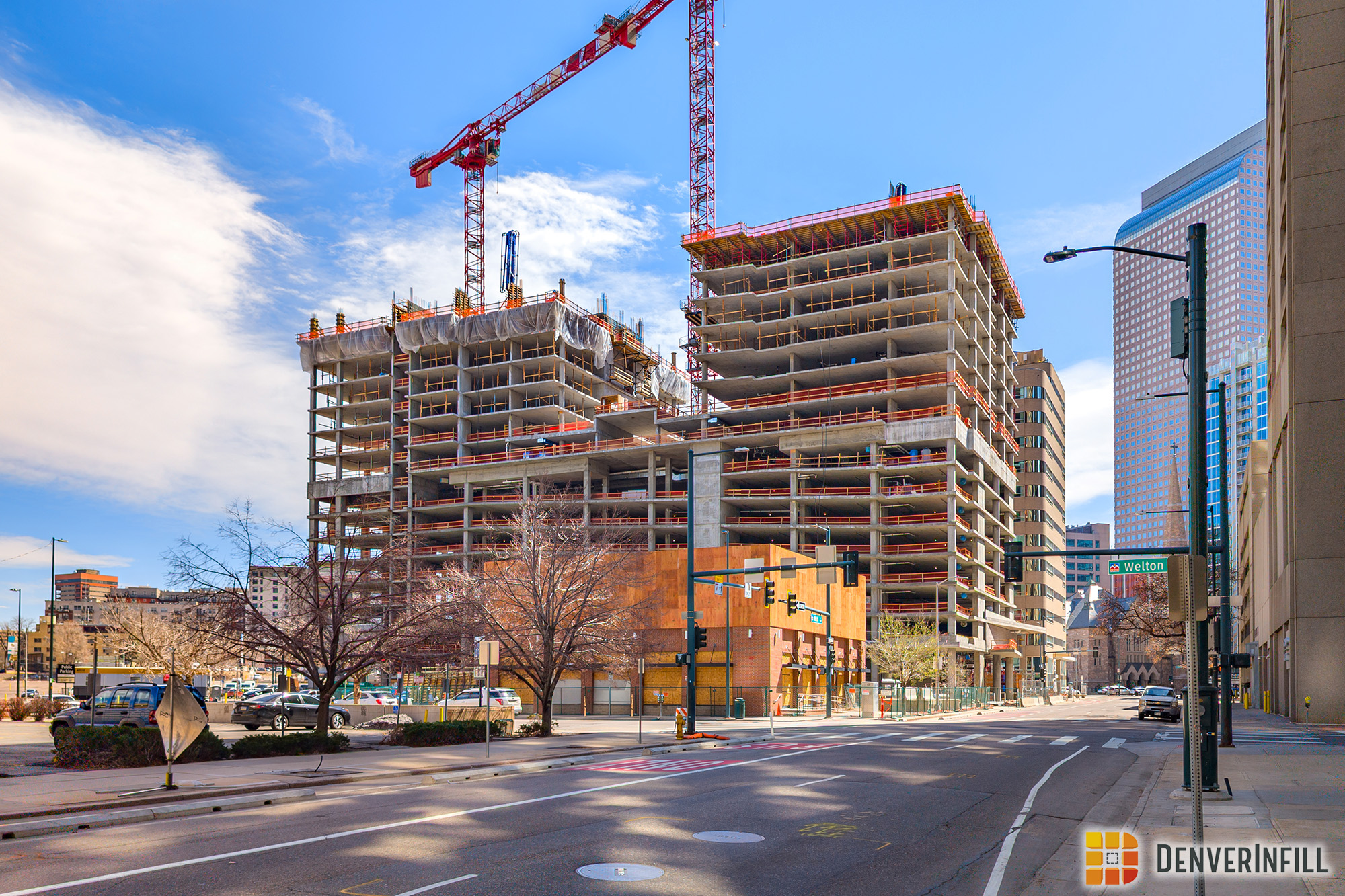As of recently, the Five Points neighborhood is starting to experience a housing boom, especially along the Welton Street Corridor. Back in June, we announced a new project, going up on the intersection of 25th and Welton Street, that will provide the neighborhood with 96 new units of housing.
Over the past few weeks, the project has broken ground, fences have been put up and excavation has begun. There will be two parts to this project: 14 townhome units and 82 apartment units. According to the site plan, the townhomes will be along Welton towards 24th Street and the apartment building will sit at the intersection of 25th and Welton Street.
Here is a closer look at 2460 Welton, just peeking over the fence.
As I was taking photos of this site, I realized that this project has one of the greatest amenities: a rail station less than a block away. This will be great when you need to catch the D-Line into Downtown Denver! The LEED-Silver project has a long ways to go with an anticipated completion about a year out.














Ryan, your photos remind us that Denver already has a streetcar line — the D. Once it’s finished to the East Line connection, ridership on the D will spike, giving commuters and air travelers an alternate line into Central Downtown, rather than Union Station.
Because the D will connect with other rail on both ends, it will work. Thousands will use it every day. This is the hybrid system first envisioned for RTD, built into the street at grade, sharing the lane with other vehicles, stopping frequently — a streetcar.
RTD bought into a now-obsolete step-up boarding design for its light rail — not wheelchair accessible at every entrance, as the new lower-floor streetcars have. In the future, Denver should be buying the new streetcars, but even with its boarding limitations, the D line will soon be very busy using the current light rail cars.
And lots of projects like 2460 Welton will be popping up along the D. Apartments AND townhouses. And retail.
Will RTD modify the D? This will be the real benchmark for Denver streetcar potential. The true measure of streetcar value, with full connectivity to other rail. And the development impact along the line, through a close-in neighborhood of low and medium-density housing, will make Five Points very attractive for living near Downtown. Especially families with children.
Land use guided by transportation planning. The D is bringing many wonderful changes to Northeast Denver. RTD, Keep the D. It’s the already-built template for intra-city rail, all over Denver — not the BRT bus plan, being promoted as cheaper.
Long-term, the city’s investment in the D Line will pay for itself in many ways beyond the fare box. The real measure of the rail investment’s value is all the positive improvements in the neighborhood along the line. The city recoups its rail investment from much higher tax revenues, from all the development sparked by the line. The rail line improves, transforms the neighborhood it serves.
Thanks, Ryan. Keep showing us those rail lines, and talking about streetcars.
Do you or anybody know the status of this central corridor extension? The last I had heard, it was permanently tabled pending a decision on conversion to a streetcar. At the time, word on the internet forums was that the ROW on Downing is too narrow to continue the dedicated light-rail lane all the way to 38th and Blake, and that true streetcars (fewer cars per train, designed to operate in mixed traffic) would be necessary to complete the link.
It has been several years since I have heard any updates on this matter. At the time, I thought that this would be a perfect “starter” streetcar line that could even be linked to Colfax via Civic Center Station using Broadway and Lincoln. Given recent discussion about the Colfax corridor though, it’s anybody’s guess what Denver and RTD are now thinking. I assume the ROW realities on Downing have not changed.
What’s most important is that the tracks are already laid into the pavement. Maybe this route, when finished to 38th and Blake, will become the first real streetcar line in the city, for more right-sized rail cars. What’s most un-likely is that RTD will “repeat history” and tear up the tracks, as was done wholesale in the ’40s.
Because the “decision” by RTD — to possibly choose another form of streetcar for the D Line — will in effect be choosing the prototype for an entire system, it’s important that this forum keep informed on what the agency’s up to. For example, would a streetcar fleet require its own maintenance yard, separate from the rest of light rail?
So Urbanists, let’s snoop around RTD for indications of where they’re going. As a public agency, they owe us that transparency. But like all public entities, they’re political, so we need to also pay attention to what the politicians are saying about the B Line, and streetcars in general.
Remember, the current ridership of the D Line is only a fraction of what it’ll be in a couple years, when it’s hooked up with the East Line to the airport. And whatever RTD says about current usage would soon be eclipsed by the finished, interconnected line’s ridership.
Will RTD actually maximize the potential of D? Or just try to neglect it out of existence, by “tabling” decisions on streetcar rolling stock? If they’re pricing a new fleet cost of streetcars, then they’ll be looking for funding, both federal and local. Which always gets back to how you finance it, and who pays? A special “benefits zone” of property owners along the line? Or all Denver citizens? A bond issue? Some kind of sales tax?
Maybe there’s money to just fund the D as a “demonstration line” with just enough streetcars purchased to make it operational. RTD and local politicians should be asked these questions.
I generally agree that RTD owes it to the taxpayers and citizens to be as transparent as possible. That said, I understand first hand why things must sometimes be kept under wraps while in development… time and money can be lost if a proposal is leaked to the public while it is still in development, and this can potentially torpedo a whole project.
But I think it’s important that we be careful using language like “WHEN finished to 38th and Blake.” The last time I checked, this extension was as dead-in-the-water as the DMU line to Boulder. rtd-fastracks.com says that they are conducting a “mobility study” right now. The FAQ states that they are essentially throwing out the 2010 preferred alternative and starting over. No alternatives have been listed yet for the current study.
I certainly wouldn’t assume that RTD is working behind the scenes to purchase new streecar rolling stock. In fact everything we have seen from them recently indicates they are moving AWAY from streetcars, not closer toward them. The recent “Northwest Area Mobility Study” actually advocates BRT over rail, as did the recent Colfax proposal.
We rail advocates should absolutely keep speaking our minds, and get involved with public outreach! But we shouldn’t assume that the rail extension is a sure thing. If Fastracks has taught us anything, it’s that nothing is ever a sure thing until it is built. RTD could just as easily propose a Champa/Curtis/Downing shuttle bus with a transfer at 30th and Downing and call it “good enough.”
Yeah, you have to fight against the BRT scam. Thankfully the cities in the Northwest (along the future NW Rail Line) are not falling for the BRT scam — the mayors have said repeatedly “We paid for rail, we want rail”. But we’ll see if they attempt to make Denver fall for it.
FWIW, the ROW on Downing is plenty wide enough for a dedicated light-rail lane all the way.
Denver planners can be a bit insane about wanting lots and lots of width for automobiles, though…
Glad to see development starting to take off. Once Welton has more people walking along the sidewalks, utilizing the Rail, and shopping along the district, this area will likely take off. On a social note; the historical black neighborhoods are seeing an influx of non-black residents. But I think people’s feelings about this are changing, for the progressive, as society at large is becoming more accepting of multi-cultural backgrounds. At least urbanites! You almost have to be; or else why are you living in a city. Point being; people just want to live in an area with nice amenities and neighbors that are equally invested in their property and who take pride in their neighborhood. I think Denver is headed in the right direction.
This is one of several projects going up in five points, which is exciting. Here is a link to some of the other projects (hope the link works, it’s from an email).
http://campaign.r20.constantcontact.com/render?ca=d406aa62-010d-426c-ad20-1d2a77a6cc90&c=4d4c82e0-7855-11e3-8262-d4ae5292b9a6&ch=4e4eb0a0-7855-11e3-827b-d4ae5292b9a6
Unfortunately, RTD is not exactly helping in the revitalization. 1) The extension is “tabled” indefinitely, 2) they moved skyride away from the Downing light rail line (this used to be a great amenity for five points residents, I used it all the time), 3) they closed the 29th and Welton Station (maybe understandable, but I disagree), and 4) they are leaving the old station standing, un-maintained to slowly decay away (not exactly an eye-pleaser, but it is cheaper for them than uninstalling it).
Welton street was also hurt by the one-way to two-way conversion of neighboring streets in Curtis Park. This has made Welton one of the few “high-speed” one-ways that commuters use to “buzz” through on their way home from downtown. Cars flying by at 50 mph is not exactly amenable to pedestrians. I’ve been trying to get a single stop sign or two installed, but city council claims they don’t have the funds. Maybe after someone get’s hit (several parked cars have already been hit), they will change their tune.
Regardless, it does feel like revitalization is finally coming to Welton St., which is exciting! Rosenberg’s bagels are pretty freaking great.
RTD’s dilemma. The “hybrid” light rail system they bought doesn’t fit at-grade on city streets. So RTD fails to deliver the streetcar system promised to Denver in-city riders, to get support for funding. Now RTD realizes they can’t make the light rail cars fit on Downing, to complete the long-promised D Line to 38th & Blake.
So RTD’s choices are:
Not finish D, “table” the project, and hope people forget about it.
Or buy new streetcars that can fit on Downing — which opens the door to the whole city-wide streetcar issue, which riders want, but politicians are afraid of because of cost.
RTD’s solution: Keep it tabled, don’t talk about it, hope the streetcar thing goes away.
Nash, Ted,
One problem that I see with several of the comments on this article is that some people are assuming that RTD would be the one to solve Denver’s intracity transit issues. They won’t. Mostly because they can’t with FasTracks incomplete but also because, even if it were completed, the rest of the metro area would not pay for Denver’s intracity rail. It only benefits Denver. Denver needs to take the lead on this; for streetcars along Welton, or Colfax, Broadway, etc.
I actually think the light rail cars are fine- they are very similar to the “step up” “T” in Boston that have worked fine on streets for over a century.
I also don’t think that the “tabling” of the extension is because it will not fit. At the community meetings RTD presented a finished design, with everything fitting. They told us it was “tabled” because of cost overruns on other lines and decreased tax revenue due to the recession. No one from RTD ever mentioned anything about it “not fitting”. They also blamed increased costs of steel for why they could not afford the extension. This was not the only line “tabled”.
It would be very expensive to add an third type of rail car (there will be light rail and commuter rail) and all the associated maintenance costs. I think the existing rail cars could work and be consistent with the tax revenue generated by Denver residents- of course Denver should pay it’s own way. Our elected RTD officials are supposed to represent us (along with the other areas they represent) to help develop our regional transportation. Denver is one of the regions.
Also, having a transportation network in one area DOES benefit the surrounding areas; at least if you are trying to get around without cars. I can go up to Boulder by bus and still get around that city.
Ted, ScottD, Jerry G, thanks for shedding a lot of light on this murky subject of streetcars, and thank you Ryan and Ken for building the platform for this discussion. Just speaking for myself, I’m probably too much of an idealist, wanting great things for Denver — but I also appreciate that some of you bring a more sober view of the hard realities of revenue streams and design details.
We can dream, we can debate, but without a strong political leader, streetcars in Denver will remain a fantasy.
Most big city politicos are liberals, who are expecting a drubbing in the coming election, especially in Congress and the Legislature. That equates to timidity, not bold leadership.
Bottom line, get ready for BRT buses on the big streets, not streetcars.
I just got back from south India. To my surprise, the governments of the cities of Hyderabad and Chennai (Madras) are investing substantially in the construction of city-metro rail systems. Other Indian cities may be doing something similar.
FWIW, Boston is switching to level-boarding (low-floor) light rail cars in order to comply with the ADA.
Everything from RTD indicates that they plan to do this too, eventually. The W line platforms are all designed to be convertible to remove the high blocks.
Jim,
I’m not quite sure where you’re getting your information on the Central Corridor Extension, but some of it is erroneous. RTD had to redo the EE/mobility study for the Central Corridor for a couple of reasons as it’s no longer valid. One of those is that the re-timing of the traffic lights in the CBD made operating the D-Line as a thru-service to Downing a lot more difficult and an extension damn near impossible. Instead RTD wants to truncate the D-Line to the DT loop and have a streetcar-style (whether that be one LRT vehicle or something else, though probably just one LRT vehicle) run from 38th & Blake through the DT Loop as well. RTD also needs to add a pocket near the convention center to improve the operating cycle of the DT Loop.
The Central Corridor Extension is coming, it’s just a question of figuring out what’s needed to make it work, what kind of expansion potential it needs, and identifying a source of funding. I think that RTD intends to apply for a DoT funding next year for the project.
Good Job D-infill! Thanks for reporting! I look forward to seeing more